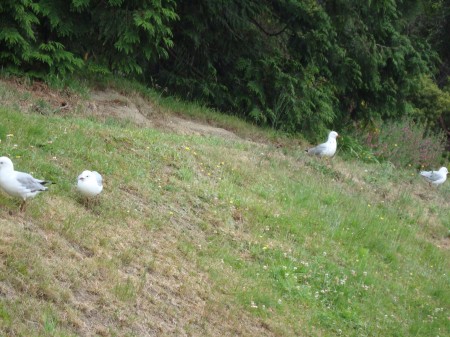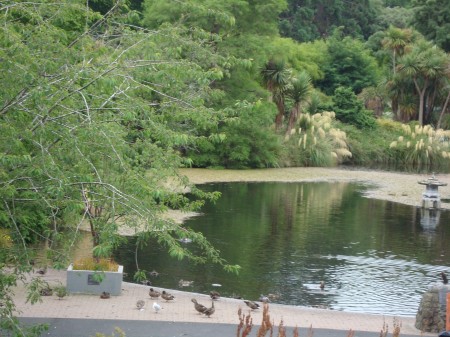Toxic Chemicals:
New Zealand Parklands Being Poisoned
This article was first published in 2010. I removed it to another website, but decided to republished it on this website, since I have been writing lately about the effects of poison drops in the Kaikorai Valley area, Dunedin. I know the local council have supported the use of 1080 drops in the past few months, and have suspected that sudden faintness, bone pains, general debilitation and sick pets is the result of these 1080 drops. I do not know whether the council here is using brodifacoum, but this is another deadly poison, and, like 1080, gets into our water and our food eventually.
Our ‘clean, green’ image, promoted by Tourism New Zealand, and one which many Kiwis fondly relate to, is a fallacy.
New Zealand has a history of rampant chemical abuse which goes back to the days of DDT, which is still in our soils. Then followed the herbicides 2,4D, and 245T, which was used here long after it was banned in the rest of the educated world.
Sadly, not much has changed: Here we are in the 21st century, with the new super Auckland City Council in charge of us up here at Orewa, in the Whangaparoa, ex-Rodney Council region. This new council of Auckland City has approved a massive drop of Brodifacoum – 30 tonnes of the stuff, to be exact – to be aerially dropped over the region of the Shakespear Sanctuary.
This is not really a surprise either, considering the compliance of the Auckland City Council over the aerial poisoning of Auckland, which took place around 2002-2005. This poisoning, done to get rid of the elusive apple moth, we were told, was, I believe, a crime against humanity. They carried on with their campaign, spraying a deluge of apple moth spray over much of Auckland, until finally, Victoria University in Wellington proved that the spray WAS damaging the health of Aucklanders. This was the moment when they were forced to stop their campaign.
Why couldn’t our own university in Auckland tackle the problem? Well, the answer is that it was a politically sensitive issue: The Auckland newspaper, “The New Zealand Herald”, was actually supporting the spraying programme by refusing to publish our on-going objections to the spray. The same newspaper blatantly ran full page advertisements to support the campaign, driven by MAF, as if the apple moth poison, and these seriously ‘concerned’ people, were seriously going to make our lives better.
The University of Auckland did nothing to come to our aid, when all the time, they had the records of student health over the period, which would have indicated the increased health problems suffered by students subjected to this poison.
Well, the Brodifacoum drop on Shakespear Park will hopefully not be on the scale of the apple moth poisoning, but it surely is a danger to all life, all the same. And it is a shame that people on the Whangaparoa Peninsula have not banded together, to make as loud a noise a possible, to try to stop the poisoning.
It seems most people on the whangaparaoa Peninsula are not even aware of the proposed Brodifacoum drop, or, if they are, they have been seduced into believing that it will not harm them. Either that, or they just don’t care.
I have seen only one letter in our local paper, “The Rodney Times”, which objected to the Brodifacoum drop. I made a response to this letter, to endorse the writer’s objections to the use of Brodifacoum, but my letter has not been published.
Merrilyn’s new book is available on Amazon:


Poison Free New Zealand: I find it interesting that most of the submissions against the spray, which were presented at a council meeting in December, 2010, come from many different places over New Zealand. I think the organization Poison Free New Zealand, and its co-ordinator Paul Cohen, are conjointly responsible for these far-reaching submissions.
The New Zealand Deer-Stalker ‘s Association has also spoken out strongly against the use of the poison Brodifacoum.
One submission against the Brodifacoum drop even comes from a Kiwi who is living in France. However, there is a single voice which speaks out against the spray, which comes from the Whangaparoa Peninsula itself.
The major concerns of the people who oppose the aerial Brodifacoum drop are that:
Brodifacoum poses a major health risk to people, animals, birds and fish in the vicinity of the drop.
Brodifacoum poison is not selective, and will kill all creatures which ingest it.
Brodifacoum also poses a threat to the wider environment, as Brodifacoum, like DDT, gets into the food chain. It does not break down easily.
Brodifacoum is a rodenticide which is a common ingredient in rat and mice poisons.
Brodifacoum causes internal haemorrhages, and these haemorrhages cause death because of resultant heart failure, or respiratory failure. These outcomes are well documented. (Kirkwood et al 1994)
One submission states that the American Bird Conservancy have cited several studies which indicate that secondary poisonings are common. A secondary poisoning is when poisoning occurs from eating flesh of an animal already contaminated with a poison, such as Brodifacoum.
The American Bird Conservancy believes that the poison Brodifacoum could be dispersed by insects which are not affected by Brodifacoum, but which harbour the pesticide within and outside their bodies. Thus insects could be carriers of the poisoned bait.
In the New Zealand Herald today and yesterday, we have been given beautiful posters of the birds of the Hauraki Gulf. This can’t be concidence, methinks. The Brodifacoum drop is about to begin:
The promotions of council so far have failed to tell us about the poisoning due to happen at Shakespear Park. Their intentions to drop 30 tonnes of Brodifacoum is being played down, and instead of warnings about the imminent poisoning, we get given these lovely posters.
One advertisement I read on a local bus just over a week ago asked for donations to protect our Shakspear Park and its birds……It gave the impression that the Auckland City Council were doing everything to look after our precious park. No mention on this ad that they are about to poison the area with rodenticide which will harm the very birds that they say they are trying to protect.
Presumably, donations received to the Auckland City Council will actually be paying for this dreadful carnage.
One writer has said that Brodifacoum has been detected in a range of game animals further up the food chain, for example, in pigs and deer, and goats, which will make the eating of wild animals unsafe. This is one reason that the New Zealand Deer Stalker’s Association have objected to the Brodifacoum drop.
But Brodifacoum has also been found to affect bird life. The New Zealand native avian species affected is large: The list includes weka, moreportk, black billed gull, saddleback,and New Zealand robin. Imported species such as chaffinch, mynah, magpie and blackbird are also vulnerable. (Eason et al 2001)
After the Rangitoto drop of Brodifacoum, thousands of pilchards died, all in the same time frame. Our authorities have declared that there is no relationship to the poison used on Rangitoto, as they said they did not find significant amounts of Brodifacoum in the fish.
However, just because scientist cannot find traces of the poison, this is no proof that the fish have not suffered a toxic reaction: It is now an established fact that some species will have adverse reactions to some poisons from exposure to miniscule amounts which cannot even be detected: This has been shown with bees, in studies which have determined the cause of bee colony collapse disorder as being exposure to miniscule amounts of nicotinoid substances which did not even show up under scientific investigation.
The reality is that all birds, all animals in the area will be affected in the long term And so will people.
People who live in the area are likely to suffer sore, burning eyes, and skin rashes in some cases. But, since Brodifacoum gets into the food chain, the long-term and wide scope of its effect cannot be underestimated. Its effects will be far reaching.
The US EPA Rodenticide Mitigation Decision of May 2008 clearly classifies Brodifacoum as a ‘PERSISTENT ORGANIC COMPOUND’ (POC).
The effect of using Persistent Organic Compounds, according to this American report, is that they “bio-accumulate along terrestrial food chains”. It states that “repeated use of POC’s, including second generation anticoagulants, is unwise and discouraged”.
The effects of Brodifacoum have been equated to the effects of DDT,another POC which has a damaging effect on the health, and a long-lasting effect in the environment and the food chain.
(see US EPA Rodenticide Mitigation Decision, May, 2008)


